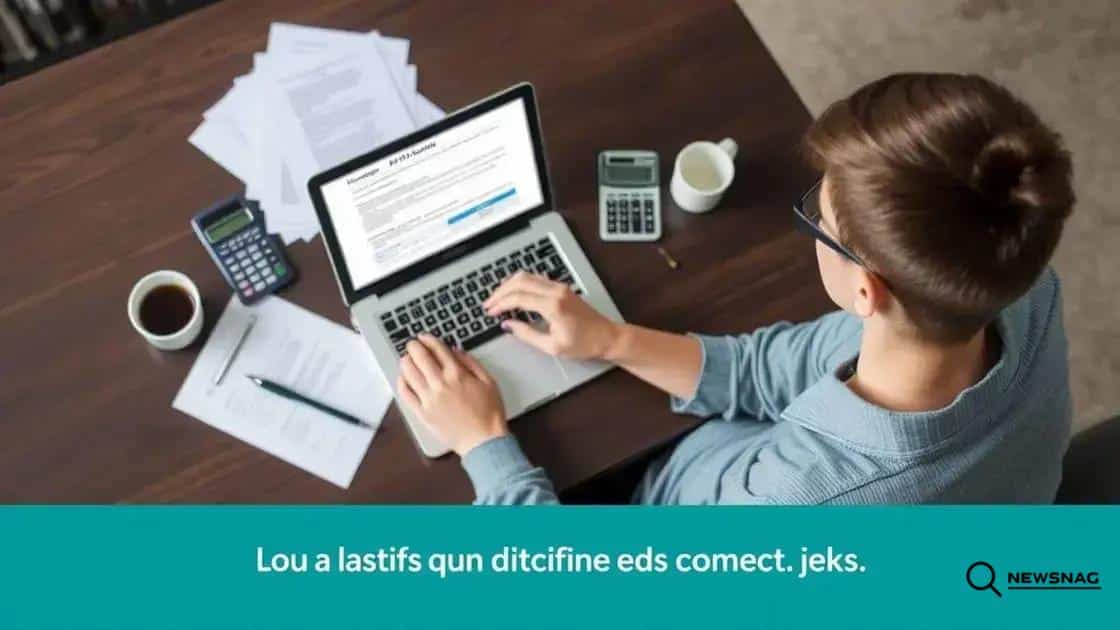Student debt relief options you might not know

Anúncios
Effective management of student loans involves creating a budget, understanding repayment plans, maintaining communication with lenders, and making extra payments to reduce debt and stress over time.
Student debt relief can feel overwhelming, but it’s crucial for many borrowers. Have you ever wondered if you qualify for assistance? This article delves into options that might surprise you and lighten your financial load.
Anúncios
Understanding student debt relief programs
Understanding student debt relief programs can be a game-changer for borrowers. These programs are designed to help you manage and reduce your student loan burden. But what exactly do they offer?
Types of Student Debt Relief
There are several types of relief that you might qualify for. They cater to different needs and financial situations. Recognizing your options is the first step!
- Income-Driven Repayment Plans: These plans adjust your monthly payments based on your income, making them more manageable.
- Public Service Loan Forgiveness: If you work for a qualifying employer, you might have your loans forgiven after a certain number of payments.
- State and Local Programs: Some states offer their own relief options, which can be valuable if you meet specific criteria.
- Loan Rehabilitation: This is an option for those who are in default, allowing you to bring your loans back into good standing.
Moreover, understanding how to apply for these programs is crucial. The application processes often vary based on the program. Some may require you to fill out specific forms, while others might ask for documentation of your income or employment status. Always ensure that you read the instructions carefully and provide all necessary information.
Anúncios
Eligibility Criteria
Different relief programs come with various eligibility requirements. Knowing what qualifies you can save you time and frustration. For example, income-driven repayment plans typically require proof of your monthly income and family size.
Don’t hesitate to reach out to your loan servicer for clarity. They can provide detailed information tailored to your circumstances. Remember that applying for relief is often easier than it seems; many borrowers find that support systems are available to guide them.
Staying informed about student debt relief programs is empowering. By exploring your options and understanding the requirements, you can take control of your financial future with confidence. Each program opens doors to new possibilities, making it essential to assess your eligibility and act as soon as possible.
Eligibility criteria for debt relief
Understanding the eligibility criteria for debt relief is essential for anyone dealing with student loans. Each program has specific requirements that borrowers must meet to qualify. By knowing these criteria, you can effectively navigate the options available to you.
General Eligibility Requirements
Most debt relief programs share some common eligibility factors. Many programs require you to have federal loans, while others focus on particular types of loans or borrowers. It’s vital to know what type of loans you have before applying.
- Federal student loans: Only federal loans are typically eligible for government-sponsored debt relief programs. Private loans usually don’t qualify.
- Repayment status: Your current repayment status may influence eligibility. Some programs require borrowers to be in good standing or not in default.
- Income requirements: Many programs assess your income level to determine eligibility. Lower income often increases your chances of qualifying.
- Employment status: Some programs focus on borrowers working in public service or other specific sectors, which can affect eligibility.
In addition to general requirements, each program may impose its own criteria. For instance, income-driven repayment plans generally require borrowers to submit annual income documentation. This helps ensure that payment terms are fair based on current financial situations.
Documenting Your Eligibility
Gathering the necessary documentation can feel daunting but is crucial for the application process. Be prepared to provide proof of income, tax returns, and loan information. Accurately reporting your financial situation can significantly impact your eligibility.
Some programs may require additional paperwork, such as proof of employment or service in a qualifying job. Understanding these nuances can help you avoid potential pitfalls during the application stage.
Staying informed about the eligibility criteria for debt relief programs empowers you to take control of your financial future. Make sure you read the requirements thoroughly and don’t hesitate to reach out for assistance if you’re unsure about your standing. The right guidance can mean the difference between relief and confusion.
How to apply for student debt forgiveness

Applying for student debt forgiveness can seem complicated, but it doesn’t have to be. Understanding the steps involved is the first move toward financial relief. Here’s a straightforward approach to get started.
Gather Necessary Documentation
Before you begin the application process, ensure that you have all required documents at hand. This typically includes your loan information and income statements. Having these ready can save you time and potential headaches down the road.
- Loan details: Know your loan type and servicer. This information is crucial for the application.
- Income documentation: Be prepared to submit pay stubs or tax returns to support your application.
- Employment records: If applying for forgiveness under specific employment programs, gather proof of your current job.
- Identification: Keep a copy of your ID or Social Security number available for verification.
After gathering your documents, review the eligibility criteria for the specific forgiveness program you’re interested in. Each program has unique requirements that you must meet to qualify. If you find it challenging to determine your eligibility, do not hesitate to reach out to your loan servicer for guidance.
Filling Out the Application
Once you are clear on the requirements, it’s time to fill out the application. Take your time and provide complete and accurate information. Many applications can be submitted online, which speeds up the process.
It’s wise to check for recurring mistakes, such as omitting details or submitting the wrong forms. Some common errors include not reporting all loans or not providing adequate documentation. These mistakes can cause delays in processing your application.
Follow Up on Your Application
After submitting your application, it’s important to follow up. Many borrowers don’t realize that applications can take time to process. Keeping in touch with your loan servicer can help you stay updated on any needed actions or changes.
Inquire about the status of your application regularly. If additional information is needed, be prompt in providing it. This shows your commitment and helps expedite the review process.
Applying for student debt forgiveness may require patience and diligence, but the potential benefits are worth the effort. The key is to stay organized, informed, and proactive throughout the entire process.
State vs. federal student debt relief options
When considering student debt relief options, it is important to understand the differences between state and federal programs. Both avenues can provide valuable assistance, but they vary significantly in terms of eligibility, benefits, and processes.
Federal Student Debt Relief Options
The federal government offers several programs aimed at helping borrowers manage their student debt. These programs are often more standardized and come with specific benefits and protections.
- Income-Driven Repayment Plans: These plans allow borrowers to pay monthly payments based on their income, which can help make payments more manageable.
- Public Service Loan Forgiveness: This program forgives remaining debt after borrowers make a certain number of qualifying payments while working in public service.
- Teacher Loan Forgiveness: Eligible teachers can receive forgiveness on a portion of their loans in exchange for teaching in low-income schools.
- Federal Direct Consolidation Loans: Borrowers can combine multiple federal loans into one loan for simpler management.
State Student Debt Relief Options
States also recognize the burden of student debt and have created their own relief programs. These tend to vary widely from one state to another, and eligibility often depends on additional factors like residency or type of employment.
Many states offer loan repayment assistance programs aimed at professionals in critical fields such as healthcare or education. Programs may also be available for individuals who have served in public service roles or underserved communities.
While state programs can be beneficial, they may have different application processes and timelines compared to federal relief options. It’s crucial to check with your state’s higher education agency for specific details on available programs.
Choosing the Right Option
Deciding between state and federal options can be difficult. Start by evaluating your personal circumstances, including your profession and financial situation. Understanding both types of relief can help you choose the best option for your needs.
Consider the potential impact of each program on your overall debt burden. Also, be sure to research and read the eligibility requirements thoroughly to avoid any surprises during the application process. Having a comprehensive understanding of state vs. federal student debt relief options will empower you to make informed decisions.
Tips for managing student loans effectively
Managing student loans effectively is crucial for financial health. With the right strategies, you can make payments more manageable and reduce stress.
Create a Budget
Start by creating a clear budget that includes all your income and expenses. This helps you see where your money goes each month. Make sure to set aside a specific amount for your student loan payments. Sticking to a budget will keep your finances on track.
- Track your expenses: Keep a record of monthly expenses to identify areas where you can cut back.
- Prioritize payments: Make student loan payments a priority in your budget to avoid late fees.
- Use budgeting apps: Consider using apps to help track and manage your finances easily.
Choose the Right Repayment Plan
Understanding your repayment options is vital. Federal loans offer various repayment plans that can be tailored to your financial situation. Explore these plans to find one that fits your income.
For example, if you have a low income, you might consider an income-driven repayment plan. This plan adjusts your monthly payments based on how much you earn, making it easier to manage. On the other hand, a standard repayment plan may offer a quicker payoff if you can afford higher payments.
Communicate with Your Lender
Open communication with your loan servicer can prevent future problems. If you’re struggling to make payments, don’t hesitate to reach out. They may offer options such as deferment or forbearance.
Also, ask about any forgiveness programs you might qualify for. By staying in touch and being proactive, you can manage your loans more effectively.
Make Extra Payments When Possible
If your budget allows, consider making extra payments on your loans. Extra payments can help reduce your principal balance and lower the total interest you pay over time.
Even small extra payments can make a difference. Set a goal for how much you want to pay extra each month, and see how it impacts your loan over time.
Overall, managing student loans requires careful planning and discipline. By implementing these tips, you can navigate your loan obligations with confidence and ease.
In conclusion, managing student loans doesn’t have to be an overwhelming task. By following these effective tips, you can take control of your financial future. Creating a budget, understanding repayment options, communicating with your lender, and making extra payments are all powerful strategies. Remember, being proactive and informed puts you in a better position to tackle your student loans successfully. With the right approach, you can reduce the stress of debt and enjoy peace of mind.
FAQ – Frequently Asked Questions about Student Loan Management
What should I include in my budget for student loan payments?
Make sure to include your monthly loan payment amount, living expenses, and any savings goals to ensure you can cover your repayment.
What options do I have if I can’t afford my student loan payments?
You can explore deferment, forbearance, or income-driven repayment plans offered by your loan servicer to reduce your monthly payments.
How can I find the right repayment plan for my student loans?
Start by assessing your financial situation and discussing options with your loan servicer, who can guide you to the best plan based on your income.
Is it beneficial to make extra payments on my student loans?
Yes, making extra payments can reduce your principal balance faster, leading to lower interest over the life of the loan, helping you pay off debt sooner.





